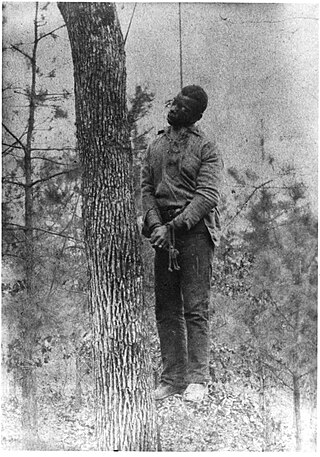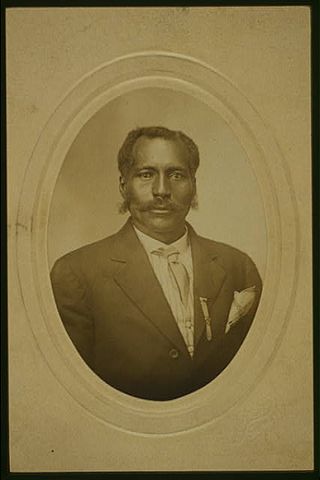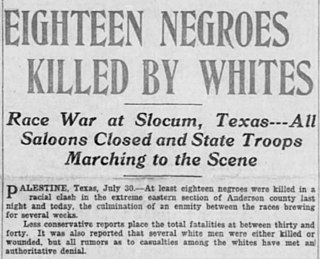Background
The body of a young white woman, Annie "Ruby" Hendry, was found with her throat slashed, lying in a pool of blood, at 4:40 p.m. on December 2, 1922, in Perry in Taylor County, Florida. Her face was badly disfigured from having been beaten with a blunt instrument, so it took half an hour to determine her identity. On December 5, the police had linked the murder weapons found at the scene, a double-barrelled shotgun and a bloody razor, to a black man who had been residing in the area and using the name "Charley Wright". He was determined to be an escaped convict from adjacent Dixie County. Search parties with guns and bloodhounds were everywhere. Each night after the body was found, buildings serving the black community in Perry were burnt down: schoolhouse, lodge, amusement hall, and then the church.
Authorities deputized local citizens and the roads were sealed. On December 6, Cubrit Dixon, a black man coming from Madison County into Taylor County, was stopped and told to put his hands up by armed citizens who had been deputized. Dixon was shot and killed when he did not comply, and witnesses said he had seemed to be reaching for a gun in his back pocket. Examination of his body found only a closed pocketknife in his back pocket.
On December 7, Albert Young, another black man, was arrested in Valdosta, Georgia. Young was an escaped convict from Kindlon, Georgia, and an acquaintance of Wright’s. On December 8, Charley Wright was arrested in Madison County and identified by police as having used the name "Jim Stalworth". Wright was then reported to have confessed to murdering Ruby Hendry and Young was reported to have admitted to having been with Wright. However, it was also reported that Wright said Young had not participated in the murder.
On December 8, 1922, a crowd of 3,000 to 5,000 white men stopped the transportation of the prisoners and took them for a kangaroo court trial. Wright was determined by the mob to be guilty and burned to death. Young was returned to sheriff's custody and taken to the jail in Taylor County. On December 12, when Young was being moved from the jail, he was abducted and shot to death by a smaller mob.
The Madison–Enterprise newspaper reported on December 15, 1922, that a black man in Perry had been "accused of writing 'an improper note' to a white woman. As retribution for these actions, the man was shot to death in his home and his home was burned down on him."
Wright, a 21-year-old escaped convict, and Albert (or Arthur) Young, his alleged accomplice, were arrested and jailed for Hendry's murder. A mob several thousand strong, made up of local and out-of-state whites, seized the accused from the sheriff, and extracted a "confession" from Wright by torturing him. Wright claimed to have acted alone. He was subsequently burned at the stake and the crowd collected souvenirs of his body parts and clothing. Following this, two more black men were shot and hanged. Whites burned the town's black school, Masonic lodge, church, amusement hall, and several families' homes.
In the broader context of racism in the United States, mass racial violence in the United States consists of ethnic conflicts and race riots, along with such events as:

Perry is a city and the county seat of Taylor County, Florida, United States. As of 2020, the population recorded by the U.S. Census Bureau was 6,898. The city was named for Madison Perry, fourth governor of the state of Florida and a Confederate colonel during the American Civil War.

The Rosewood massacre was a racially motivated massacre of black people and the destruction of a black town that took place during the first week of January 1923 in rural Levy County, Florida, United States. At least six black people were killed, but eyewitness accounts suggested a higher death toll of 27 to 150. In addition, two white people were killed in self-defense by one of the victims. The town of Rosewood was destroyed in what contemporary news reports characterized as a race riot. Florida had an especially high number of lynchings of black men in the years before the massacre, including the lynching of Charles Strong and the Perry massacre in 1922.

Red Summer was a period in mid-1919 during which white supremacist terrorism and racial riots occurred in more than three dozen cities across the United States, and in one rural county in Arkansas. The term "Red Summer" was coined by civil rights activist and author James Weldon Johnson, who had been employed as a field secretary by the National Association for the Advancement of Colored People (NAACP) since 1916. In 1919, he organized peaceful protests against the racial violence.

Lynching was the widespread occurrence of extrajudicial killings which began in the United States' pre–Civil War South in the 1830s and ended during the civil rights movement in the 1950s and 1960s. Although the victims of lynchings were members of various ethnicities, after roughly 4 million enslaved African Americans were emancipated, they became the primary targets of white Southerners. Lynchings in the U.S. reached their height from the 1890s to the 1920s, and they primarily victimized ethnic minorities. Most of the lynchings occurred in the American South, as the majority of African Americans lived there, but racially motivated lynchings also occurred in the Midwest and border states. In 1891, the largest single mass lynching in American history was perpetrated in New Orleans against Italian immigrants.

Rosewood is a 1997 American historical drama film directed by John Singleton, inspired by the 1923 Rosewood massacre in Florida, when a white mob killed black people and destroyed their town. In a major change, it stars Ving Rhames as an outsider who comes into Rosewood and inspires residents to self-defense, wielding his pistols in a fight. The supporting cast includes Don Cheadle as Sylvester Carrier, a resident who was a witness, defender of his family and victim of the riot; and Jon Voight as John Wright, a sympathetic white store owner who lives in Rosewood. The three characters become entangled in an attempt to save people from racist White people attacking the Black residents of Rosewood.

The People's Grocery lynchings of 1892 occurred on March 9, 1892, in Memphis, Tennessee, when black grocery owner Thomas Moss and two of his workers, Will Stewart and Calvin McDowell, were lynched by a white mob while in police custody. The lynchings occurred in the aftermath of a fight between whites and blacks and two subsequent shooting altercations in which two white police officers were wounded.
On May 16, 1918, a plantation owner was murdered, prompting a manhunt which resulted in a series of lynchings in May 1918 in southern Georgia, United States. White people killed at least 13 black people during the next two weeks. Among those killed were Hazel "Hayes" Turner and his wife, Mary Turner. Hayes was killed on May 18, and the next day, his pregnant wife Mary was strung up by her feet, doused with gasoline and oil then set on fire. Mary's unborn child was cut from her abdomen and stomped to death. Her body was then repeatedly shot. No one was ever convicted of her lynching.

Anthony Crawford was an African American man who was killed by a lynch mob in Abbeville, South Carolina on October 21, 1916.

The Longview race riot was a series of violent incidents in Longview, Texas, between July 10 and July 12, 1919, when whites attacked black areas of town, killed one black man, and burned down several properties, including the houses of a black teacher and a doctor. It was one of the many race riots in 1919 in the United States during what became known as Red Summer, a period after World War I known for numerous riots occurring mostly in urban areas.
The Ocoee massacre was a mass racial violence event that saw a white mob attack numerous African-American residents in the northern parts of Ocoee, Florida, a town located in Orange County near Orlando. Previously inhabited by the Seminoles, Ocoee was the home to 255 African-American residents and 560 white residents according to the 1920 Census. The massacre took place on November 2, 1920, the day of the U.S. presidential election leaving a lasting political, but also community impact, as the 1930 census shows 1,180 whites, 11 Native Americans, and 2 African Americans (0.2%).
The lynching of Marie Thompson of Shepherdsville took place in the early morning on June 15, 1904, in Lebanon Junction, Bullitt County, Kentucky, for her killing of John Irvin, a white landowner. The day before Thompson had attempted to defend her son from being beaten by Irvin in a dispute; he ordered her off the land. As she was walking away from him, he attacked her with a knife and she killed him in self-defense with a razor. She was arrested and put in the county jail.

On April 13, 1937, Roosevelt Townes and Robert McDaniels, two black men, were lynched in Duck Hill, Mississippi by a white mob after being labeled as the murderers of a white storekeeper. They had only been legally accused of the crime a few minutes before they were kidnapped from the courthouse, chained to trees, and tortured with a blow torch. Following the torture, McDaniels was shot to death and Townes was burned alive.
John Hartfield was a black man who was lynched in Ellisville, Mississippi in 1919 for allegedly having a white girlfriend. The murder was announced a day in advance in major newspapers, a crowd of as many as 10,000 watched while Hartfield was hanged, shot, and burned. Pieces of his corpse were chopped off and sold as souvenirs.

The Slocum massacre occurred on July 29–30, 1910, in Slocum, Texas, an unincorporated community in Anderson County near Palestine in East Texas. Only six deaths were officially confirmed, but some 22 were reported by major newspapers. This is the official count, but it is estimated that as many as one hundred African Americans were killed.

The Newberry Six lynchings took place in Newberry, Alachua County, Florida, on August 18, 1916.
The Danville race riot occurred on July 25, 1903, in Danville, Illinois, when a mob sought to lynch a Black man who had been arrested. On their way to county jail, an altercation occurred that led to the death of a rioter and the subsequent lynching of another Black man. At least two other Black residents were also assaulted. The rioters failed to overtake the police stationed at the jail and the Illinois National Guard restored order the next day.

A mob of white Vigo County, Indiana, residents lynched George Ward, a black man, on February 26, 1901 in Terre Haute, Indiana, for the suspected murder of a white woman. An example of a spectacle lynching, the event was public in nature and drew a crowd of over 1,000 white participants. Ward was dragged from a jail cell in broad daylight, struck in the back of the head with a sledgehammer, hanged from a bridge, and burned. His toes and the hobnails from his boots were collected as souvenirs. A grand jury was convened but no one was ever charged with the murder of Ward. It is the only known lynching in Vigo County. The lynching was memorialized 120 years later with a historical marker and ceremony.

Jesse Thomas was a 23-year-old, African-American man who was murdered in Waco, McLennan County, Texas by Sam Harris on May 26, 1922. A large mob then seized the body from the undertaker and burnt it in Waco's public square. The lynching of Jesse Thomas was the 10th lynching in 20-days in Texas and according to the United States Senate Committee on the Judiciary it was the 30th of 61 lynchings during 1922 in the United States.













